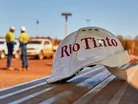Inside Rio Tinto's Scope 3 Resistance

Rio Tinto, one of the world’s largest mining companies, has defended its decision not to set targets for emissions produced by customers using its products.
While the company has pledged to achieve net zero emissions from its operations by 2050, it remains under pressure from investors and campaigners to take greater accountability for its full carbon footprint.
The miner’s targets focus on reducing emissions directly under its control (scope 1 and 2). These include a 15% reduction by 2025, 50% by 2030 and net zero by 2050.
However, Scope 3 emissions — generated when customers process and use Rio’s iron ore, primarily for steelmaking — account for 95% of the company’s total emissions last year.
Operational progress and investments
Rio Tinto has made strides in reducing its operational emissions. By the end of 2023, it reported a 6% reduction compared to its 2018 baseline and remains confident of reaching its 2030 goal.
To support these efforts, the company has committed to spending up to US$6bn on decarbonisation projects by the end of the decade.
However, unlike its peers, Rio has stopped short of setting Scope 3 targets. Competitors such as Anglo American, BHP and Glencore have announced ambitious goals to address these emissions.
Anglo American aims for a 50% reduction in Scope 3 emissions by 2030, while BHP and Glencore are targeting net zero Scope 3 emissions by 2050.
Despite this, Rio is not ignoring the issue. The company is “actively piloting potential solutions” with customers to reduce emissions across the steel supply chain.
Jonathon McCarthy, Rio’s Chief Decarbonisation Officer, defended the company’s position, emphasising the challenges of setting targets for emissions beyond its direct control.
“At the moment, the answer is do everything you can to make your value chain move faster but don’t set a target you can’t control, is the advice we get on balance from the community we work with,” Jonathon explained.
Steel production, which relies heavily on iron ore, is responsible for between 7% and 9% of global fossil fuel emissions, according to the World Steel Association.
Scope 3 under scrutiny
Investor and campaigner focus on Scope 3 emissions continues to grow, reflecting a broader push for companies to address the entire lifecycle impact of their products.
For Rio Tinto, this pressure has come from groups like the Australasian Centre for Corporate Responsibility (ACCR), which advocates for greater transparency and ambition.
Naomi Hogan, company strategy lead at the ACCR, acknowledges Rio’s progress but calls for further steps: “Rio Tinto’s upcoming Scope 3 disclosures, alongside growing ambition and investment partnerships for green iron and green steel, should put the company in a position to set a clear Scope 3 target in future.”
In response to investor concerns, Rio has agreed to provide enhanced disclosures on its Scope 3 reduction plans ahead of its next annual meeting in March.
This commitment signals a potential shift towards greater accountability, even if formal targets remain off the table for now.
The challenge of green steel
A key component of Rio’s strategy lies in its collaboration with customers to develop “green steel” solutions.
Green steel refers to steel production methods that reduce or eliminate carbon emissions, often through the use of hydrogen or other emerging technologies. While these innovations are promising, they remain in the early stages of development and adoption.
Rio argues that setting formal Scope 3 targets at this stage could prove counterproductive, given the complexities of the steel industry and the limitations of current technologies. Instead, it believes the focus should be on fostering practical solutions and accelerating progress through partnerships and investment.
However, critics argue that targets — however aspirational — can provide a clear framework for action and accountability.
Balancing ambition with practicality
Rio Tinto’s stance highlights the broader challenge facing industries with significant Scope 3 emissions: balancing ambition with what can realistically be achieved.
While the company continues to reduce its operational emissions and invest in decarbonisation, its decision not to set Scope 3 targets sets it apart from competitors.
For now, Rio is prioritising collaboration and innovation, recognising that progress on scope 3 emissions requires systemic change across the steel supply chain.
Make sure you check out the latest industry news and insights at Scope 3 Magazine and be part of the conversation at our global conference series, Sustainability LIVE and Procurement & Supply Chain LIVE.
Discover all our upcoming events and secure your tickets today. Subscribe to the Scope 3 Magazine newsletter.
Scope 3 Magazine is a BizClik brand.
Featured Articles
Estonia, Latvia and Lithuania join the European grid, cutting ties with Russian energy, a move that boosts regional security and sustainability
TÜV SÜD: New battery regulations bring Scope 3 hurdles, requiring sustainable sourcing, digital traceability and design changes increasing compliance
Nissan is scaling up its use of green steel, reducing CO2 emissions in its supply chain as part of its goal to achieve carbon neutrality by 2050


